
(a)
Interpretation:
The hybridization of the central atom of the molecules with the following molecular geometries has to be predicted.
- (a) Tetrahedral (b) trigonal planar (c) trigonal bipyramidal (d) linear (e) octahedral
Concept Introduction:
Hybridization is a hypothetical concept. It refers to overlapping of atomic orbitals and the resultant orbitals formed are known as hybrid orbitals. An orbital that doesn’t involve in hybridization is termed as unhybridized orbital. After hybridization, the orbitals cannot be distinguished individually. The orientation of the orbitals while overlapping impacts the nature of the bond forms. By knowing the hybridization of central atom in the molecule its geometry can be predicted and vice-versa.
(a)
Answer to Problem 7.52QP
| Molecular Geometry | Hybridization of the central atom | |
| (a) | Tetrahedral |
|
Explanation of Solution
Tetrahedral
A molecule having tetrahedral geometry has the empirical formula
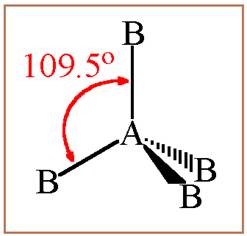
Figure 1
The bond angle between two atoms in a tetrahedral molecule is
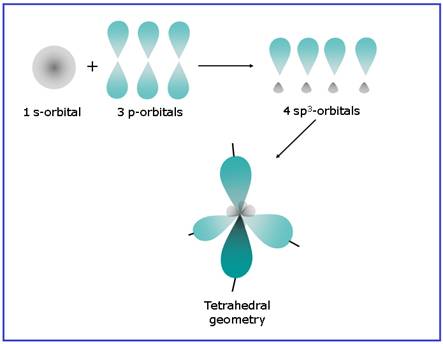
Figure 2
Thus a molecule having tetrahedral geometry has central atom with
(b)
Interpretation:
The hybridization of the central atom of the molecules with the following molecular geometries has to be predicted.
- (a) Tetrahedral (b) trigonal planar (c) trigonal bipyramidal (d) linear (e) octahedral
Concept Introduction:
Hybridization is a hypothetical concept. It refers to overlapping of atomic orbitals and the resultant orbitals formed are known as hybrid orbitals. An orbital that doesn’t involve in hybridization is termed as unhybridized orbital. After hybridization, the orbitals cannot be distinguished individually. The orientation of the orbitals while overlapping impacts the nature of the bond forms. By knowing the hybridization of central atom in the molecule its geometry can be predicted and vice-versa.
(b)
Answer to Problem 7.52QP
| Molecular Geometry | Hybridization of the central atom | |
| (b) | Trigonal planar |
|
Explanation of Solution
Trigonal planar
A molecule having trigonal planar geometry has the empirical formula
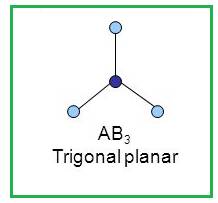
Figure 3
The bond angle between two atoms in a trigonal planar molecule is
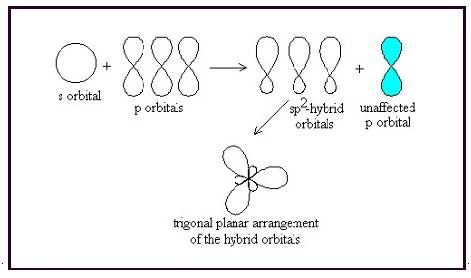
Figure 4
Thus a molecule having trigonal planar geometry has central atom with
(c)
Interpretation:
The hybridization of the central atom of the molecules with the following molecular geometries has to be predicted.
- (a) Tetrahedral (b) trigonal planar (c) trigonal bipyramidal (d) linear (e) octahedral
Concept Introduction:
Hybridization is a hypothetical concept. It refers to overlapping of atomic orbitals and the resultant orbitals formed are known as hybrid orbitals. An orbital that doesn’t involve in hybridization is termed as unhybridized orbital. After hybridization, the orbitals cannot be distinguished individually. The orientation of the orbitals while overlapping impacts the nature of the bond forms. By knowing the hybridization of central atom in the molecule its geometry can be predicted and vice-versa.
(c)
Answer to Problem 7.52QP
| S.No | Molecular Geometry | Hybridization of the central atom |
| (c) | Trigonal bipyramidal |
|
Explanation of Solution
Trigonal bipyramidal
A molecule having trigonal bipyramidal geometry has the empirical formula
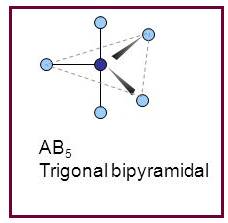
Figure 5
Trigonal bipyramidal molecule has two set of bonds – two axial bonds and three equatorial bonds. The two axial bonds are
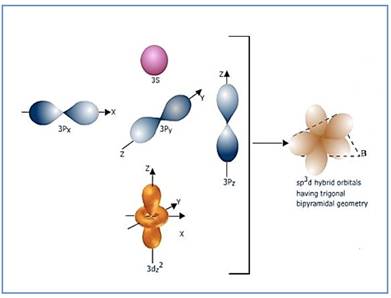
Figure 6
If the d-orbital of the
(d)
Interpretation:
The hybridization of the central atom of the molecules with the following molecular geometries has to be predicted.
- (a) Tetrahedral (b) trigonal planar (c) trigonal bipyramidal (d) linear (e) octahedral
Concept Introduction:
Hybridization is a hypothetical concept. It refers to overlapping of atomic orbitals and the resultant orbitals formed are known as hybrid orbitals. An orbital that doesn’t involve in hybridization is termed as unhybridized orbital. After hybridization, the orbitals cannot be distinguished individually. The orientation of the orbitals while overlapping impacts the nature of the bond forms. By knowing the hybridization of central atom in the molecule its geometry can be predicted and vice-versa.
(d)
Answer to Problem 7.52QP
| S.No | Molecular Geometry | Hybridization of the central atom |
| (d) | Linear |
|
Explanation of Solution
Linear
A molecule having linear geometry has the empirical formula
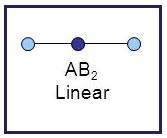
Figure 7
The bond angle between two atoms in linear molecule is
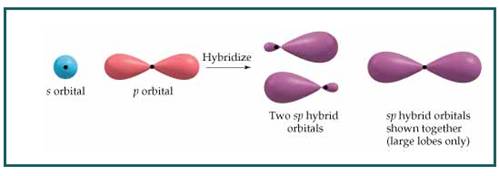
Figure 8
Thus a molecule having linear geometry has central atom with
(e)
Interpretation:
The hybridization of the central atom of the molecules with the following molecular geometries has to be predicted.
- (a) Tetrahedral (b) trigonal planar (c) trigonal bipyramidal (d) linear (e) octahedral
Concept Introduction:
Hybridization is a hypothetical concept. It refers to overlapping of atomic orbitals and the resultant orbitals formed are known as hybrid orbitals. An orbital that doesn’t involve in hybridization is termed as unhybridized orbital. After hybridization, the orbitals cannot be distinguished individually. The orientation of the orbitals while overlapping impacts the nature of the bond forms. By knowing the hybridization of central atom in the molecule its geometry can be predicted and vice-versa.
(e)
Answer to Problem 7.52QP
| S.No | Molecular Geometry | Hybridization of the central atom |
| (e) | Octahedral |
|
Explanation of Solution
Octahedral
A molecule having octahedral geometry has the empirical formula
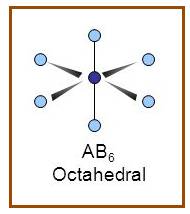
Figure 9
The bond angle between two atoms in octahedral molecule is
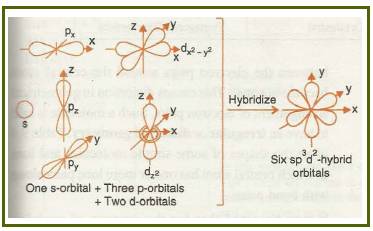
Figure 10
If the d-orbital of the
The hybridization of the central atom of the molecules with the given molecular geometries has been predicted.
Want to see more full solutions like this?
Chapter 7 Solutions
Chemistry Atoms First, Second Edition
- Write the electron configuration of an atom of the element highlighted in this outline of the Periodic Table: 1 23 4 5 6 7 He Ne Ar Kr Xe Rn Hint: you do not need to know the name or symbol of the highlighted element! ☐arrow_forwardCompare these chromatograms of three anti-psychotic drugs done by HPLC and SFC. Why is there the difference in separation time for SFC versus HPLC? Hint, use the Van Deemter plot as a guide in answering this question. Why, fundamentally, would you expect a faster separation for SFC than HPLC, in general?arrow_forwardA certain inorganic cation has an electrophoretic mobility of 5.27 x 10-4 cm2s-1V-1. The same ion has a diffusion coefficient of 9.5 x 10-6cm2s-1. If this ion is separated from cations by CZE with a 75cm capillary, what is the expected plate count, N, at an applied voltage of 15.0kV? Under these separation conditions, the electroosmotic flow rate was 0.85mm s-1 toward the cathode. If the detector was 50.0cm from the injection end of the capillary, how long would it take in minutes for the analyte cation to reach the detector after the field was applied?arrow_forward
- 2.arrow_forwardPlease solve for the following Electrochemistry that occursarrow_forwardCommercial bleach contains either chlorine or oxygen as an active ingredient. A commercial oxygenated bleach is much safer to handle and less likely to ruin your clothes. It is possible to determine the amount of active ingredient in an oxygenated bleach product by performing a redox titration. The balance reaction for such a titration is: 6H+ +5H2O2 +2MnO4- à 5O2 + 2Mn2+ + 8H2O If you performed the following procedure: “First, dilute the Seventh Generation Non-Chlorine Bleach by pipetting 10 mL of bleach in a 100 mL volumetric flask and filling the flask to the mark with distilled water. Next, pipet 10 mL of the diluted bleach solution into a 250 mL Erlenmeyer flask and add 20 mL of 1.0 M H2SO4 to the flask. This solution should be titrated with 0.0100 M KMnO4 solution.” It took 18.47mL of the KMnO4 to reach the endpoint on average. What was the concentration of H2O2 in the original bleach solution in weight % assuming the density of bleach is 1g/mL?arrow_forward
- 10.arrow_forwardProper care of pH electrodes: Why can you not store a pH electrode in distilled water? What must you instead store it in? Why?arrow_forwardWrite the electron configuration of an atom of the element highlighted in this outline of the Periodic Table: 1 23 4 569 7 He Ne Ar Kr Xe Rn Hint: you do not need to know the name or symbol of the highlighted element! §arrow_forward
- Identify the amino acids by name. Illustrate a titration curve for this tetrapeptide indicating the pKa's for each ionizable groups and identify the pI for this tetrapeptide. please helparrow_forward↓ ina xSign x Sign X labs X Intro X Cop Xa chat X My Cx Grac X Laur x Laur xash learning.com/ihub/assessment/f188d950-dd73-11e0-9572-0800200c9a66/d591b3f2-d5f7-4983-843c-0d00c1c0340b/f2b47861-07c4-4d1b-a1ee-e7db2 +949 pts /3400 K Question 16 of 34 > © Macmillan Learning Draw the major E2 reaction product formed when cis-1-chloro-2-ethylcyclohexane (shown) reacts with hydroxide ion in DMSO. H CH2CH3 H H HO- H H H Cl DMSO H H C Select Draw Templates More C H 0 2 Erasearrow_forwardA common buffer for stabilizing antibodies is 100 mM Histidine at pH 7.0. Describe the preparation of this buffer beginning with L-Histidine monohydrochloride monohydrate and 1 M NaOH. Be certain to show the buffering reaction that includes the conjugate acid and base.arrow_forward
 Chemistry: Principles and PracticeChemistryISBN:9780534420123Author:Daniel L. Reger, Scott R. Goode, David W. Ball, Edward MercerPublisher:Cengage Learning
Chemistry: Principles and PracticeChemistryISBN:9780534420123Author:Daniel L. Reger, Scott R. Goode, David W. Ball, Edward MercerPublisher:Cengage Learning Chemistry: Principles and ReactionsChemistryISBN:9781305079373Author:William L. Masterton, Cecile N. HurleyPublisher:Cengage Learning
Chemistry: Principles and ReactionsChemistryISBN:9781305079373Author:William L. Masterton, Cecile N. HurleyPublisher:Cengage Learning Chemistry: The Molecular ScienceChemistryISBN:9781285199047Author:John W. Moore, Conrad L. StanitskiPublisher:Cengage Learning
Chemistry: The Molecular ScienceChemistryISBN:9781285199047Author:John W. Moore, Conrad L. StanitskiPublisher:Cengage Learning Chemistry & Chemical ReactivityChemistryISBN:9781337399074Author:John C. Kotz, Paul M. Treichel, John Townsend, David TreichelPublisher:Cengage Learning
Chemistry & Chemical ReactivityChemistryISBN:9781337399074Author:John C. Kotz, Paul M. Treichel, John Townsend, David TreichelPublisher:Cengage Learning Chemistry & Chemical ReactivityChemistryISBN:9781133949640Author:John C. Kotz, Paul M. Treichel, John Townsend, David TreichelPublisher:Cengage LearningChemistry: Matter and ChangeChemistryISBN:9780078746376Author:Dinah Zike, Laurel Dingrando, Nicholas Hainen, Cheryl WistromPublisher:Glencoe/McGraw-Hill School Pub Co
Chemistry & Chemical ReactivityChemistryISBN:9781133949640Author:John C. Kotz, Paul M. Treichel, John Townsend, David TreichelPublisher:Cengage LearningChemistry: Matter and ChangeChemistryISBN:9780078746376Author:Dinah Zike, Laurel Dingrando, Nicholas Hainen, Cheryl WistromPublisher:Glencoe/McGraw-Hill School Pub Co





